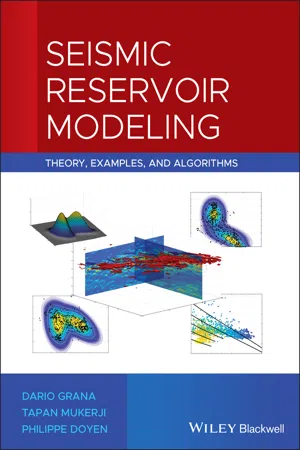
Seismic Reservoir Modeling
Theory, Examples, and Algorithms
Dario Grana, Tapan Mukerji, Philippe Doyen
- English
- ePUB (disponibile sull'app)
- Disponibile su iOS e Android
Seismic Reservoir Modeling
Theory, Examples, and Algorithms
Dario Grana, Tapan Mukerji, Philippe Doyen
Informazioni sul libro
Seismic reservoir characterizationaimsto build 3-dimensional models of rock and fluid properties, including elastic and petrophysicalvariables, to describe andmonitor the state of the subsurfacefor hydrocarbonexploration andproduction andforCO? sequestration. Rock physics modeling and seismic wave propagation theory provide a set of physical equations to predict the seismic response of subsurface rocks based on their elastic and petrophysical properties. However, the rock and fluid properties are generally unknown and surface geophysical measurements areoftenthe only available data to constrain reservoir models far away from well control. Therefore, reservoirproperties are generally estimated from geophysical data as a solution of an inverse problem, by combining rock physics and seismic models with inverse theory and geostatistical methods, in the context of the geologicalmodelingof the subsurface. A probabilistic approach to the inverse problem provides the probability distribution of rock and fluid properties given the measured geophysical data and allows quantifying the uncertainty of the predicted results. The reservoir characterization problem includes both discrete properties, such as facies or rock types, and continuous properties, such as porosity, mineral volumes, fluid saturations, seismic velocities and density.
Seismic Reservoir Modeling: Theory, Examples and Algorithms presentsthe main concepts and methods of seismic reservoir characterization. The book presents an overview ofrock physics models that link the petrophysical properties to the elastic properties in porous rocksand a review of themost common geostatistical methods to interpolate and simulate multiple realizations of subsurface propertiesconditionedon a limited number of direct and indirect measurementsbased onspatial correlation models.Thecore of the bookfocuses onBayesian inverse methods for the prediction ofelasticpetrophysical properties from seismic data using analytical and numerical statistical methods.The authors presentbasic and advancedmethodologies of the current state of the art in seismic reservoir characterizationand illustrate themthrough expository examples as well as real data applications to hydrocarbon reservoirs and CO?sequestration studies.